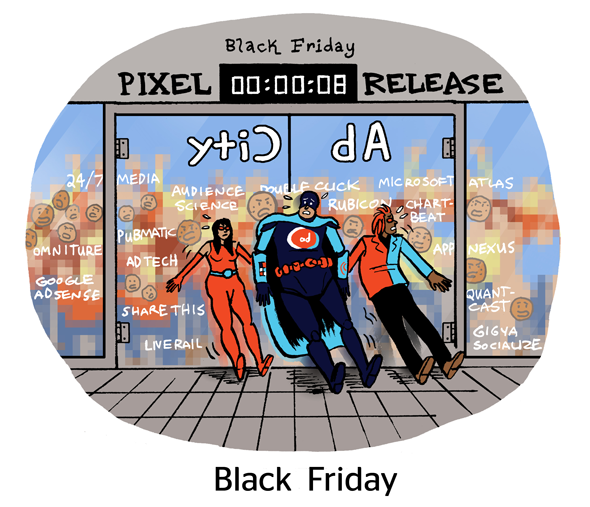Target reported $649 million in revenue from its Roundel advertising business in 2024, up about 25% from 2023, during its Q4 and full-year earnings report on Tuesday.
The ad revenue growth was a bright spot, in an otherwise flat year for America’s second-largest retail chain operator.
Target’s full-year net sales actually declined by 3% compared to the year before, while net income and operating income were down by 20%, per the filing.
Target’s difficult financial footwork
One thing Target is dealing with is a tricky period of year-over-year comparisons.
For one thing, 2023 was a 53-week year with extra days carried in the holiday shopping season, compared to 52 weeks in 2024. On a day-per-day basis, 2024 net sales would be up by 1%, said CFO Jim Lee.
Up a smidge is not great, mind. But it sure beats a 3% decline in net sales.
Later this year, he said, Target will enjoy favorable comparisons to a relatively weak stretch when there was low inventory and supply chain issues.
For another example of how finnicky it can be to use year-over-year growth rates as a basis of measurement, Target’s stock price has declined by 24% in the past calendar year. Check back in two days though. If share prices remain the same, Target’s yearly stock decline will be 36%, since it will lap a large jump from last year when Target reported 2023 earnings.
A day here or there can make a surprising (and arbitrary) change in apparent results.
The advertising story
A frequent question for Target’s digital and data-driven operation is whether the group prefers to drive traffic to physical stores or the site, said Cara Sylvester, the chief guest experience officer (and formerly the chief marketing and digital officer).
It’s a leading question, because the conventional wisdom is that any given sale at a store is more profitable than the same purchase made online.
And that conventional wisdom is correct, Sylvester said. But Target’s ecommerce business has flipped to profitability in the past year, she added, “and that’s without adding the benefits of Roundel and Target Plus.”
When more sellers join Target Plus, which is the retailer’s third-party marketplace, the Roundel ad business onboards more customers. Roundel brings incremental new business and creates more customers who are part of Target’s data warehouse and can receive personalized ads. Customers spend 20% more with Target on average after they’ve used the buy-online store pickup or same-day delivery through Target’s Shipt service, said CEO Brian Cornell. “And perhaps surprisingly to some, they also spend more in-store as well.”
Store sales may be more profitable, compared out of context. But data and advertising bring future returns.
“And, importantly, it’s scalable,” Lee said. Target’s ecommerce sales have more than tripled in the past five years, but its investments to fulfill those orders haven’t increased much at all. The company’s store-based footprint is the same and it hasn’t had to ramp up hiring or redesign locations for online pick-ups.
Sylvester said Target sees a path for Roundel to double in size in the next five years.
However, the company has lagged behind Walmart in data and advertising. Three years ago, the Walmart Connect ad business reported full-year 2022 ad revenue of $700 million, a little more than Target’s ad services in 2024. Last month, Walmart said its 2024 ad business totaled $4.4 billion.
Growing Roundel from about $650 million to $1.3 billion by 2030 seems quite doable by comparison.
When Target first disclosed advertising revenue in 2022, it actually reported $1 billion in ad revenue for 2021. Target’s ad business hasn’t declined, so much as the accounting structure changed so the ad segment more accurately depicts Roundel. And Target remains solidly atop the third tier of retail media networks (there’s Amazon, then Walmart, then the Target, Kroger and Albertsons set).
But investors and other retailers are still eyeing Target, waiting to see if another big retail chain could make the jump to scaled advertising power-player.














